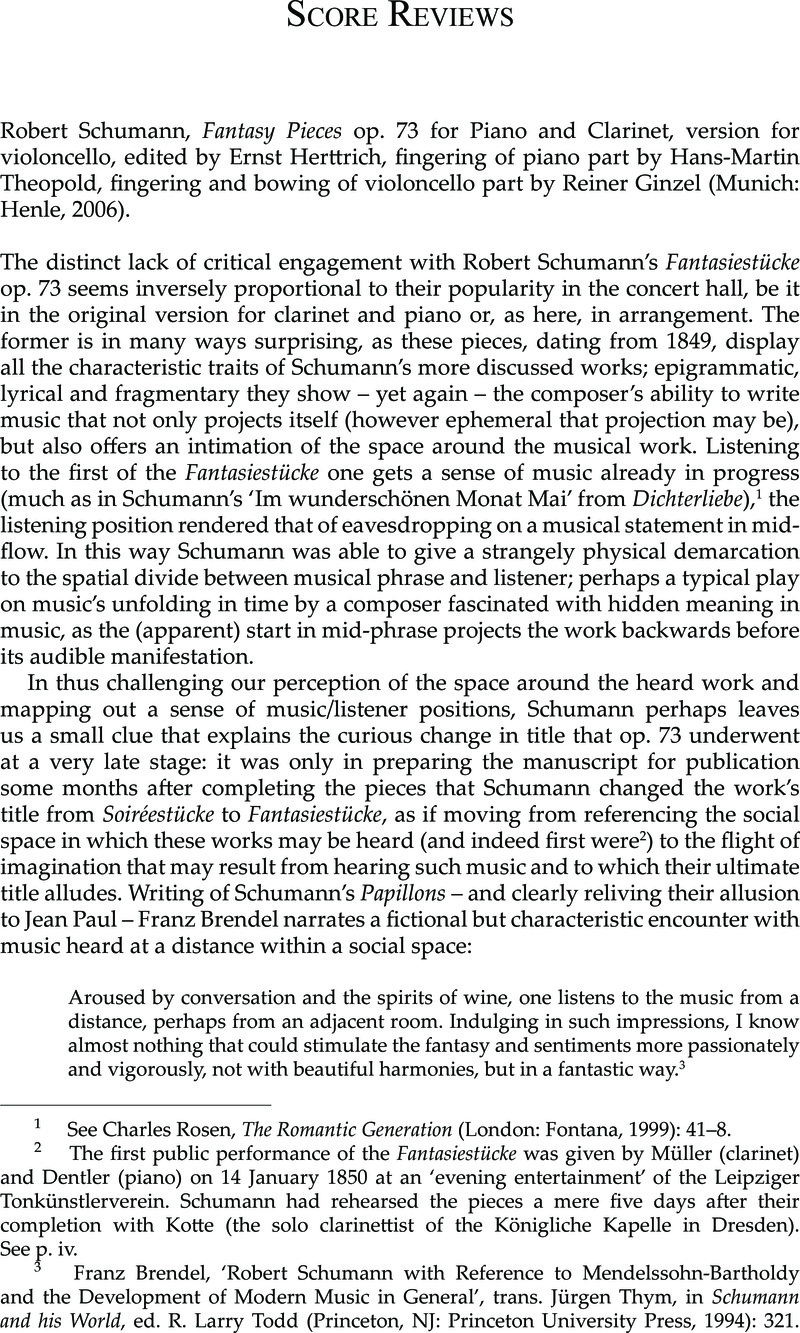No CrossRef data available.
Published online by Cambridge University Press: 13 April 2011

1 See Rosen, Charles, The Romantic Generation (London: Fontana, 1999): 41–8.Google Scholar
2 The first public performance of the Fantasiestücke was given by Müller (clarinet) and Dentler (piano) on 14 January 1850 at an ‘evening entertainment’ of the Leipziger Tonkünstlerverein. Schumann had rehearsed the pieces a mere five days after their completion with Kotte (the solo clarinettist of the Königliche Kapelle in Dresden). See p. iv.
3 Brendel, Franz, ‘Robert Schumann with Reference to Mendelssohn-Bartholdy and the Development of Modern Music in General’, trans. Thym, Jürgen, in Schumann and his World, ed. Todd, R. Larry (Princeton, NJ: Princeton University Press, 1994): 321.Google Scholar The influence of Jean Paul's writings on the compositional aesthetics of Schumann is well documented. Nevertheless, I would draw the reader's attention to Leon Botstein's excellent account in ‘History, Rhetoric and the Self: Robert Schumann and Music Making in German-Speaking Europe, 1800–1860’, in Todd, , ed., Schumann and his World: 7–16Google Scholar.
4 See Edler, Arnfried, ‘Robert Schumann’, in Die Musik in Geschichte und Gegenwart, ed. Finscher, Ludwig, 2nd edn (Kassel: Bärenreiter, 2006), Personenteil, vol. 15: 306.Google Scholar
5 Brendel, , ‘Robert Schumann’: 320.Google Scholar
6 Charles Rosen makes a similar point when he writes: ‘in the sets of short piano pieces by Schumann – the Papillons, the Davidsbündlertänze, the Humoresk – there is, not a specific narrative program, but the suggestion of a program, an implied narrative that cannot be spelled out but that carries the music along and holds the work together.’ Rosen, , The Romantic Generation: 87Google Scholar.
7 Schumann had completed the score to Manfred on 23 November 1848 and had made final revisions of Genoveva in January 1849.
8 Diary entry Robert Schumann of Febuary 1849, quoted in Edler, ‘Robert Schumann’: 316. Edler considers these works to collectively constitute the development of ‘a new kind of fantasy piece in piano chamber music’ in which Schumann ‘transferred the fantasy-or character-piece developed in the pianistic realm in the “Davidsbündler period” to chamber music’ ( Edler, , ‘Robert Schumann’: 316).Google Scholar
9 Edler has argued that Schumann's works from this period mirror the contemporary interest in new sound combinations in orchestral music in music for smaller ensembles destined for ‘the private and semi-public musical sphere’. Edler, , ‘Robert Schumann’: 316.Google Scholar
10 Edler, , ‘Robert Schumann’: 273Google Scholar . See also Daverio, John, ‘Robert Schumann’, in Sadie, Stanley ed., The New Grove Dictionary of Music and Musicians, 2nd edn (London: Macmillan, 2001): vol. 22, 782Google Scholar.
11 This discrepancy does not appear to have been felt as such by Schumann, writing to Franz Brendel on 17 June 1849, ‘alas, to tell music of the pains and joys that move our time, that, I feel is my lot more than any other's’. Quoted in Ulrich Lenz, ‘Robert Schumann: Fantasiestücke op. 73 für Klarinette und Klavier [1849]’, available online at www. christinemitlehner.de/texte/schum_fantasie73_txt.htm (accessed 27 November 2006).
12 The following outline of events is indebted to Ernst Herttrich's account in his preface to the edition under review.
13 Schumann noted the ‘splendid’ playing of the violinist Ferdinand David and Clara Schumann at the home of Prince Reuss in Leipzig in 1852 in a recital that included Schumann's Sonata in A (op. 105) and the Fantasiestücke. See p. iv.